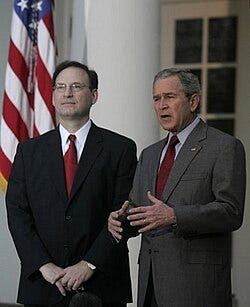Wrapping Up 2005 and 2006
Two big years in the confirmation wars
Let’s wrap up the momentous first two years of George W. Bush’s second term.
Those years were ushered in by the November 2004 elections, which, in addition to extending Bush’s presidency for another four years, expanded the Republican majority in the Senate from a very tight 51-to-49 edge to a very comfortable margin of 55 to 45. Those years ended after the November 2006 elections, in which Senate Democrats ran the table in all of the close races and regained control of the Senate that would convene in January 2007.
***
With a Supreme Court vacancy on the horizon, Senate majority leader Bill Frist’s big challenge was to find a way to defeat Democratic senators’ filibustering of judicial nominees. The enlarged Republican majority offered the hope that Frist could muster the 50 votes that he needed (along with Vice President Dick Cheney’s tie-breaking vote) to abolish the filibuster for judicial nominations. But the Gang of 14 Agreement in May 2005 preempted the floor vote on abolishing the filibuster: its bipartisan signatories preserved the filibuster but also committed to resort to it only in exceptional circumstances.
When not one, but two, Supreme Court seats opened up in the summer of 2005, the Gang of 14 Agreement gave John Roberts a very smooth path to confirmation as chief justice, and it prevented Senate Democrats from making any serious effort to block Samuel Alito’s confirmation as associate justice.
Before Bush nominated Alito to replace Sandra Day O’Connor, he had selected his White House counsel Harriet Miers for that seat. The successful revolt of the conservative legal movement against the Miers pick showed that conservatives were no longer going to accept a Republican president’s “trust me” assurance on a Supreme Court nominee.
Bush would also affect the long-term trajectory of the Supreme Court with two of his appellate picks. By appointing Brett Kavanaugh to the D.C. Circuit and Neil Gorsuch to the Tenth Circuit in 2006, he placed them in position for the Supreme Court appointments they would receive just over a decade later.
***
Bush’s record in 2005 and 2006 on appellate appointments is mixed. The Gang of 14 Agreement led to the prompt confirmations of conservative stalwarts like William Pryor (Eleventh Circuit) and Janice Rogers Brown (D.C. Circuit) who had previously been filibustered, and it ensured Bush leeway to get other judges confirmed.
But Bush appointed only 16 appellate judges in 2005 and 2006 (compared to 19 in the filibuster years of 2003 and 2004). In part because neither the White House nor Republican senators anticipated that the 2006 elections would return control of the Senate to Democrats, he left 16 or so appellate seats unfilled, including four on the Fourth Circuit and two on the D.C. Circuit. Of the ten appellate picks that were in play late in 2006, only four would end up getting confirmed.
Never take upcoming elections for granted.



